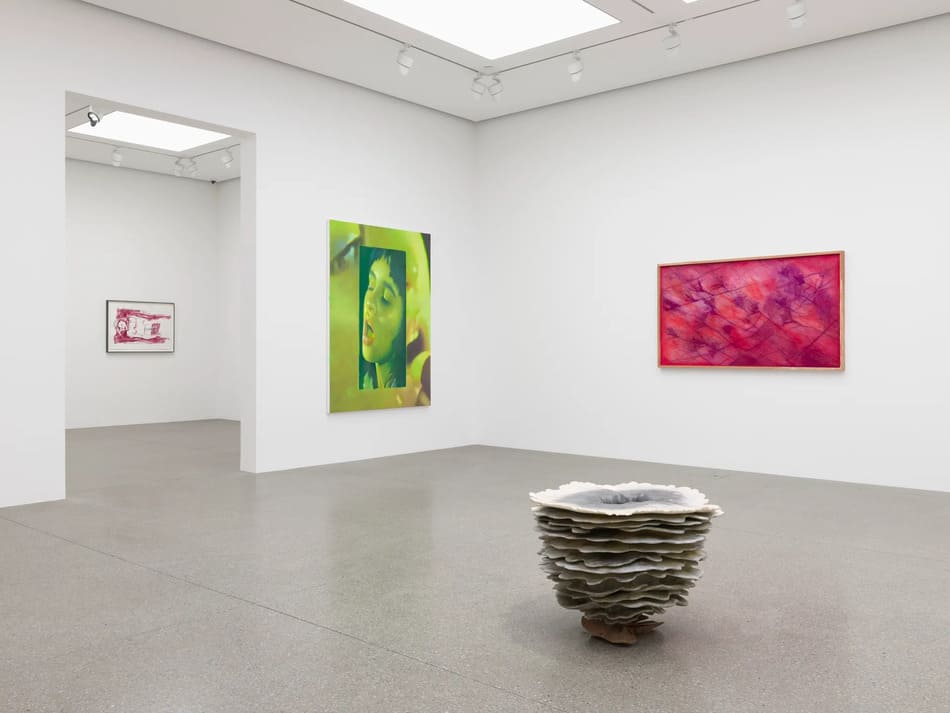Art | November 13, 2023 |

The Embodied Spirit
White Cube Seoul, South Korea
September 05, 2023 – December 21, 2023
‘The Embodied Spirit’ brings together works which explore ideas around philosophy, metaphysics and what motivates human behaviour. The inseparable nature of body and psyche, as posited by the Greek philosopher Aristotle in his essay On the Soul (c.350 BCE), provides the basis for a selection of artworks that delve into the mysteries of human existence, interpreting the continuum between matter and spirit.

Christine Ay Tjoe’s paintings examine spiritual concepts and emotional conditions, achieved by a process in which the artist enters a near transcendental state as a route to achieving a merger of what she describes as ‘the seen and unseen’. Delicate colour fragments explode and skitter across the surface plane of the paintings, governed by the artist’s intuition in her search for the interconnectivity between humanity and nature. In the ‘Cryptobiosis’ (2020) works – a term meaning the state of extreme inactivity that an organism enters in response to adverse environmental conditions – Ay Tjoe looks ‘to virtually halt movement and any definite aim ahead; offering possibilities for a longer life and greater hope ahead’.The enigma of human life and what comes next is the subject of Marguerite Humeau’s wide-ranging practice. Exploring what she describes as ‘the consciousness of our death as individuals and as a species’, Humeau’s sculptures and works on paper present a series of speculative forms and models that she imagines might emerge in a post-Anthropocene world.

The Guardian of Termitomyces (2023) takes the form of a totem, based on the termite mounds built through collective cooperation, which the artist sees as a guide to ‘navigate our futures’. The paintings of Louise Giovanelli explore heightened emotional states, rituals, religion and iconography. A single image sourced from a 1970s film featuring the sacramental offering to a young woman during a Catholic mass provides the catalyst for a series of paintings in which the protagonists hover somewhere between pious reverence, ecstatic reverie and erotic abandonment. The acid yellow/green pallor that pervades the images alludes to altered perceptions resulting from transubstantiation – the changing of one substance into another. Lee Jinju’s paintings consider the psychological process of individual memory and perception. Using traditional Korean painting techniques, applying ink or pigment directly onto fabric, her delicately rendered views of hands or the back of a head, focus on details drawn from her personal narrative and subjective approach. As Lee explains, ‘My ‘Black Paintings’ series reveals a hidden yet unmanifested structure where many events and relationships remain concealed in darkness […] I believe that hands, like a person’s face, can express a multitude of emotions. Tracey Emin probes the fundamentals of what makes us human with excoriating honesty. Spiritual consciousness and the prospect of an afterlife are recurrent themes, while ideas around love, desire, loss and grief echo throughout the paintings and works on paper.

In I Have to Keep Living (2022), the outline of a contorted female figure lying across a bed-like structure with the palimpsest of earlier iterations of a ghost-like form visible beneath suggests a tumultuous emotional state. In The Next Journey (2023), the supine figure seen on a sarcophagus-shaped crib appears as if hovering between this life and the next. Katharina Fritsch’s uncanny sculptures are full of intuitive intent. Based on objects or forms that are instantly familiar, through the application of solid colour or alteration of scale, they take on a more ambiguous and mysterious presence and in doing so present some of the most profound questions of human existence. In Hand (2020), a single outstretched hand, laid flat on a plinth, appears lifelike in its exquisite detail, yet otherworldly in its matt black finish, loaded with association and import. Embodiments of human fragility, drawn from religious iconography, feature in the work of Berlinde de Bruyckere. Inspired by mythology, Old Master painting and Christian representation, her anamorphic forms focus on the pathos of life, yet through a contemporary lens. The compassionate care provided by nurses and caregivers during the global pandemic triggered a group of sculptures titled the ‘Arcangelo’ series. In Arcangelo Glass Dome II (2021–23), hybrid human forms enveloped in soft fur, extend the metaphor of protection for the vulnerable body.
more. www.whitecube.com

